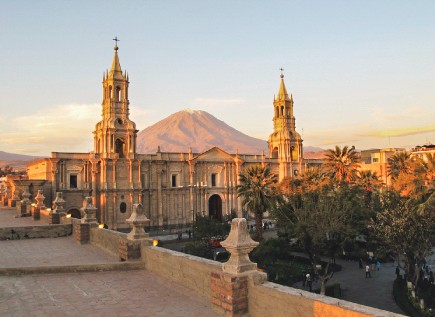Santa Catalina Monastery: The Architectural Masterpiece
The Santa Catalina Monastery is renowned worldwide as a colonial architectural masterpiece. The monastery is home to many complex rooms, beautiful plazas, ornate fountains and winding cobblestone streets. As one of the most popular attractions in Arequipa, this is not one to be missed during your visit!
This monastery was built in 1579 and was funded by a rich widow, Maria de Guzman. At the time, it was tradition that the second son or daughter of the family would enter into a life of service to the church and only women from upper-class families were accepted. When these women were accepted, they had to pay a dowry in order to enter service, therefore most nuns were extremely wealthy at the time and not many poorer women could enter service. If a woman was to enter the monastery as a choir-nun, she would have to pay a dowry of 2,400 silver coins (the equivalent of approximately $150,000 (US) today.
In 1871, Pope Pius IX sent a strict dominican nun, Sister Josefa Cadena to reform the Santa Catalina Monastery. She sent all the rich dowries back to Europe, freed any slaves and allowed them to choose whether to remain in service in the monastery or to leave. In the 1960s, the monastery was struck by two powerful earthquakes, severely damaging the inner structures and forcing the nuns to build newer accommodation next to the monastery. The damaged areas of The Santa Catalina Monastery were gradually restored and are now open to the public.
It is over 20,000 square metres and while most of the building is now a paid tourist attraction. While the monastery once housed approximately 450 people, (both nuns and servants)there are now only approximately 20 nuns living in the northern corner of the building. Admission tickets cost around 40 soles and there are guides inside the monastery that offer tours for about 20 soles. These guides speak many languages such as: Spanish, English, French, German, Italian, Portuguese and Japanese.
While we recommend exploring the monastery with the aid of one of the multilingual, knowledgeable guides, you can also explore the monastery alone. The monastery is open two evenings a week so that visitors can roam the grounds in candlelight as the nuns would have done years ago. If you choose to navigate the monastery without the aid of a guide, we recommend visiting the three main cloisters:
The Novice Cloister
Marked by a rubber tree at its entrance, this was an area where nuns were required to swear a vow of silence and dedicate their lives to prayer and work. Nuns served as novices for 4 years, whereby their families had to pay a dowry of 100 gold coins per year. At the end of the 4 years, the novice could choose between entering into a full life of service or to leave the convent (bringing shame upon her family).
Orange Cloister
This was where nuns went after they graduated from novice. This cloister earned its name from the cluster of orange trees at its centre. Found in this area is the Profundis Room – A room where deceased nuns are mourned and their portraits line the walls. As you leave the orange cloister, down Córdova street, cells that served as living quarters for the nuns can be found. The cafe can also be found while leaving the orange cloister, serving fresh pastries and coffees.
The Great Cloister
This cloister is bordered by the chapel and the art gallery. The gallery in the past was used a communal dormitory. This building was constructed in the shape of a cross, with the walls sporting murals of Jesus and The Virgin Mary.
Viewing The Santa Catalina Monastery provides the visitor with a deep understanding of what life was like in these types of monasteries hundreds of years ago. If you enjoy history or architecture, then you need to pay a visit to The Santa Catalina Monastery. If you would like to discover more of the city in a unique way, I would definitely suggest booking a free walking tour through FindLocalTrips.com, a safe and reliable trip comparison site operating all over South America. Happy Travels!



